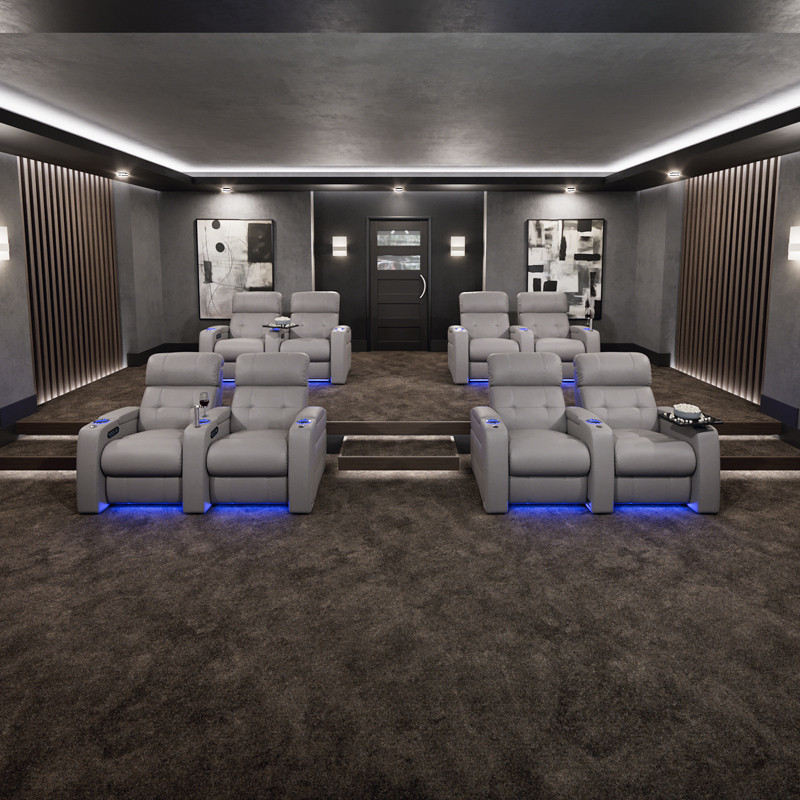Professional Tampa Home Theater Installation for a Seamless Setup
Professional Tampa Home Theater Installation for a Seamless Setup
Blog Article
Home Theater 101: Whatever You Required to Know for a Cinematic Experience in the house
Developing a home cinema that measures up to the cinematic experience of a commercial theatre involves mindful factor to consider of numerous elements, including screen option, sound systems, and space design. Whether you are considering the optimal screen dimension or the details of border noise, understanding these fundamentals is essential.
Choosing the Right Screen
When establishing a home theater, picking the right screen can make or break the watching experience - home theater design tampa. The screen acts as the focal point of your configuration, influencing photo high quality, seeing angles, and total visual. Key variables to think about include display size, kind, and resolution
Initially, figure out the suitable display dimension based on your space measurements and seating range. Next, select in between various screen kinds, such as fixed-frame, mechanized, or retractable screens, each offering unique benefits.
Resolution is another vital variable. For an absolutely immersive experience, think about a display designed for 4K or perhaps 8K web content, ensuring sharpness and clearness. In addition, consider the screen's gain, which affects brightness and contrast; a higher gain can improve brightness in well-lit spaces, while a reduced gain might be better for darker environments.
Choosing Sound Equipment
Audio tools is a critical component of any home theater system, substantially improving the general watching experience. The choice of audio gear can figure out the deepness, clearness, and immersion of noise, important for producing a motion picture environment.
When selecting audio devices, think about a surround sound system, which usually consists of a receiver, several speakers, and a subwoofer. A 5.1 or 7.1 channel system is recommended, where the first number stands for the audio speakers and the 2nd the subwoofer, offering an immersive soundscape. The receiver is the heart of the system, managing sound and video clip signals, and must support modern formats like Dolby Atmos for a boosted spatial experience.
Quality audio speakers are necessary; look for models that offer a well balanced noise profile with good bass feedback. Floor-standing audio speakers can produce richer sound, while shelf choices conserve room. Furthermore, consider cordless choices for simplicity of installation, although wired systems usually provide exceptional efficiency.

Optimal Seating Plans
Developing an excellent home theater experience hinges considerably on ideal seating arrangements. The arrangement of seats plays a critical function in both comfort and checking out high quality, straight influencing the general cinematic experience.
First, consider the screen size and seeing distance. A common standard is to place seats at a distance approximately 1.5 to 2.5 times the angled size of the screen. This makes certain an immersive experience without stressing the eyes.
Next, altitude is vital. The back rows need to be higher than the front to avoid blockages if your seating is in a tiered style. For flat seats, guarantee that the front row is not also near to the screen, which everyone has a clear view.
Furthermore, take into consideration the plan in regards to social dynamics. Team seating can boost the communal experience, while private seats may be liked for individual watching.

Last but not least, prioritize convenience with ergonomic seats that supports prolonged watching periods. Recommended Site Integrating reclining chairs or cushioned seats can substantially boost the experience, making the home theater a favored location for both home entertainment and leisure.
Lighting and Setting
Effective lights and ambiance are vital parts of a well-designed home theater, as they dramatically influence the seeing experience. The appropriate illumination can boost the cinematic feel, while bad options can interfere with it. For optimum results, think about a layered illumination strategy that consists of ambient, job, and accent lighting.
Ambient lighting offers general illumination, making sure that the area is not entirely dark, which can stress the eyes. Dimmer buttons are very advised, permitting changes based upon the web content being watched. Job lights, such as wall surface sconces or flooring lights, uses useful lighting for tasks like reading or navigating the space without disrupting the overall atmosphere.
Accent lights can be made use of to highlight building features or develop centerpieces, adding deepness and rate of interest to the space. LED strip lights behind displays or along racks can offer a refined radiance that enhances the aesthetic experience without overwhelming the audience.

Wiring and Installation Tips
A well-planned electrical wiring setup is important for achieving optimal efficiency in your home theater system. Correct circuitry not only guarantees top quality sound and video clip signals however also boosts the general aesthetic of your room. Begin by mapping out your format, recognizing where each element will certainly be put, including your screen, audio speakers, and receiver.
When choosing cables, prioritize top notch, properly gauged circuitry to decrease signal loss. HDMI wires must be used for video clip connections, while speaker cord must match the specifications of your audio speakers and amplifier. Choose for in-wall ranked cords to adhere to security criteria and preserve a tidy look.

Final Thought
In recap, developing an outstanding home theater experience requires careful address consideration of different aspects, consisting of display choice, audio devices, seating setups, lights, and circuitry. By focusing on these variables, a motion picture ambience can be efficiently reproduced, permitting for immersive watching experiences that measure up Full Article to typical cinema setups.
Developing a home movie theater that equals the motion picture experience of an industrial theatre involves careful factor to consider of numerous elements, including screen selection, sound systems, and area design.When setting up a home theater, selecting the appropriate display can make or break the viewing experience. Next, pick in between different screen kinds, such as fixed-frame, mechanized, or retractable screens, each offering distinctive benefits. For a really immersive experience, consider a display created for 4K or even 8K content, ensuring intensity and clearness.In recap, developing an outstanding home theater experience calls for mindful consideration of numerous aspects, including display selection, audio tools, seating plans, lights, and electrical wiring.
Report this page